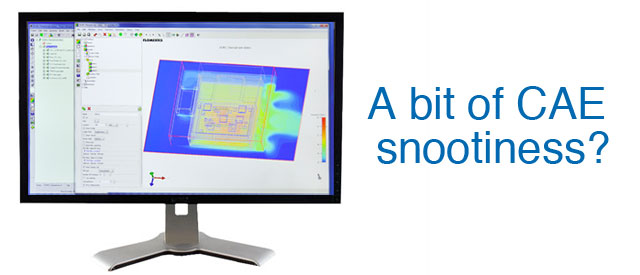
The importance of working collaboratively and the ability to share native geometry with our clients has necessitated us investing in a fairly extensive range of Computer Aided Design (CAD) and Computer Aided Analysis (CAE) software over the years. This gives us a good insight into the strengths and weaknesses of a number of the most commonly used CAD and CAE packages, as we work with them on day to day, or project to project basis (see our article “SolidWorks or Pro/ENGINEER? No Contest!”)
When it comes to the CAE, we use the built-in CAD-based tools, such as SolidWorks Flow Simulation and Pro/MECHANICA within Pro/ENGINEER, in fairly equal measure to the specialist packages such as ANSYS and Mentorgraphics’ FLOTHERM. The CAD-based plug-ins offer the distinct advantage of operating seamlessly within the design tool, with both pre-and post-processing done in the CAD domain. This is highly beneficial where there is a likelihood that some iteration / optimisation will be required, as the associativity between the native geometry and the mesh, loads, and boundary conditions are maintained.
The alternative is that the geometry is exported from CAD (usually in the form of STEP or IGES) and imported to a separate CAE tool. Meshing and adding loads & constraints in the CAE domain means that if changes are required to the geometry then either this has to be done in the CAE tool in which case the CAD is not in sync, or in the CAD tool thus necessitating fresh import and the re-application of loads etc.
The perception in the industry seems to be that, while CAD-based tools are good for a “quick look-see”, if you want credible results that stand up to scrutiny then only a specialist tool will do. However, here at the “coal face” of engineering design we wonder if there’s a bit of residual CAE snootiness going on here? This perception is at odds with our day-to-day findings, as increasingly the CAD-based analysis tools are giving the specialist systems a run for their money, and in some cases can yield better results.
The solvers used behind the CAD tools are from quality software stables anyway, and the CAD-based pre-processors have modern algorithms for meshing and up-to-date user-interfaces. There are still clear niches where the specialist solvers dominate and to a certain extent I suspect this will continue to be the case whilst CAD vendors continue to target all industries. By way of example, a key advantage the FLOTHERM suite offers us over the SolidWorks Flow Simulation tool is not necessarily the solving capability, but its extensive library of electronic components.
Surely I’m not alone in thinking this? I’d be pleased to hear from anyone with similar (or differing!) views.
John.
Warley Design provides mechanical design, engineering and product development services to a broad range of industries. To find out more call us now on 01277 261066 or email us.